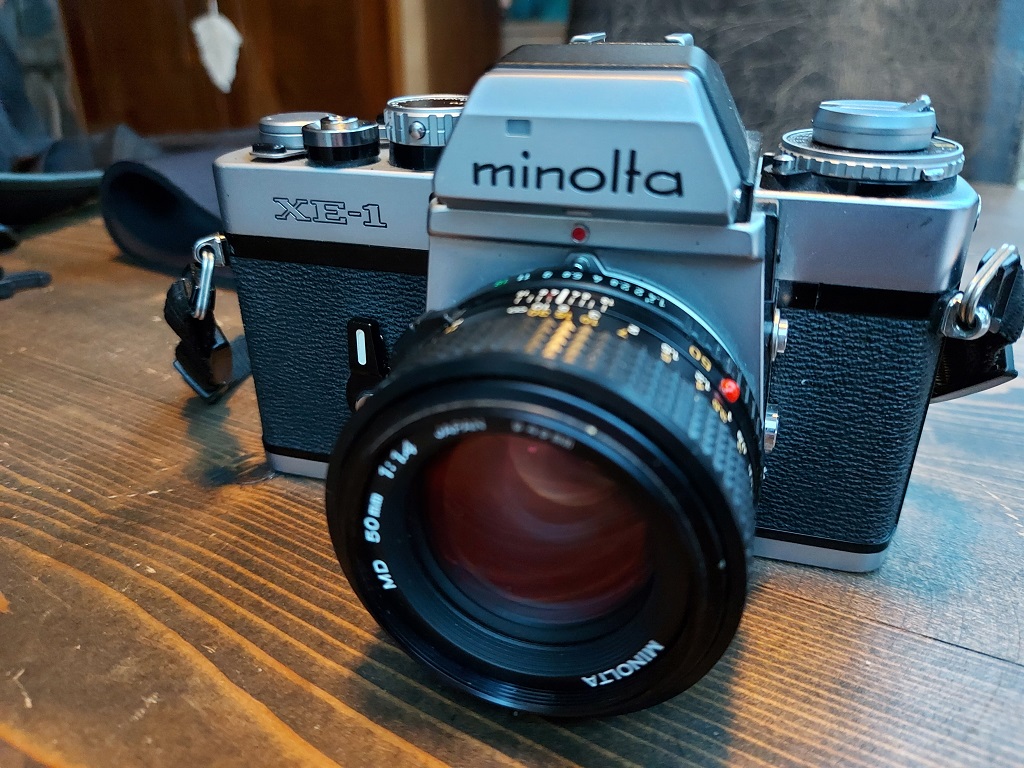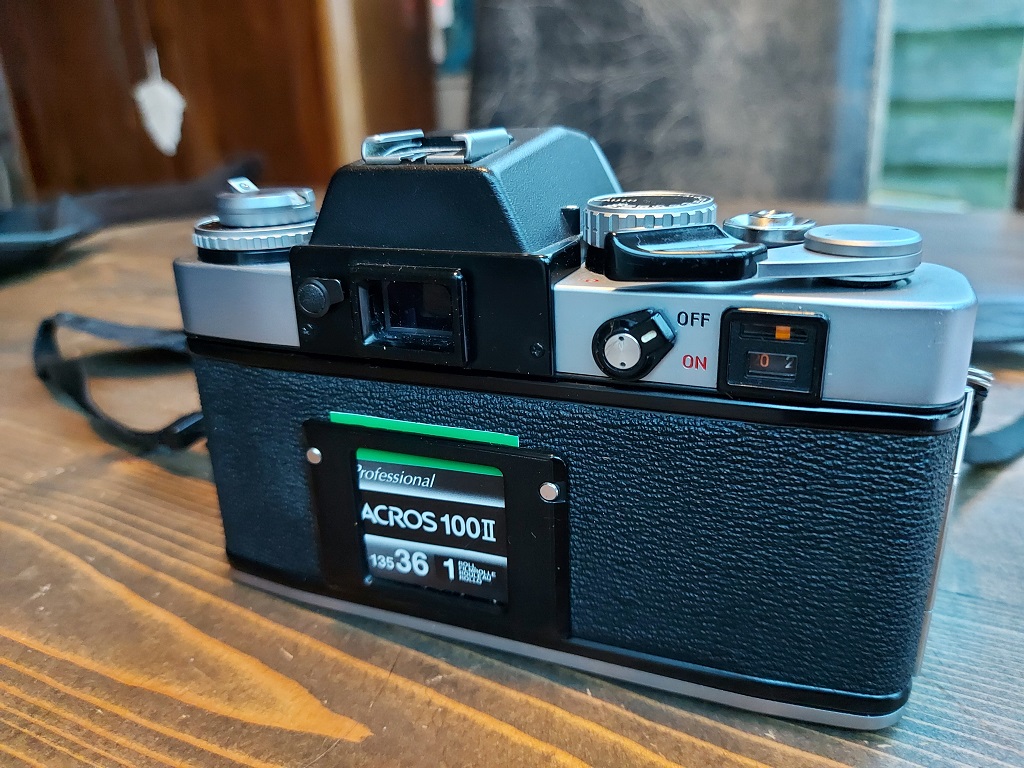The first half of the seventies was an era in which the Japanese camera industry was busy designing and building cameras up to a quality level, not down to a price. Sure, there were consumer, prosumer and professional-grade models, but the primary difference would be the number of available features, but the build quality would be the same along the model line. Nikon, Canon, Minolta and Asahi-Pentax were all churning out cameras which represented the best they could make. In fact, they were so good that, back in 1977, a leading camera journalist once wrote something like “I have a spread of six pages to fill about this new camera… and all I can come up with is, it’s perfect’” (quoting from memory). The traditional European camera industry was lagging behind in build quality as well as in competitiveness.
In fact, the industry was busy digging its own grave. By creating The Perfect Camera, built to last for decades, they choked their own market – there was no incentive for the customer to replace it.
And then, in 1977, Canon released the AE-1 upon an unsuspecting market. The AE-1 was definitely designed and engineered “down to a price”, which was so low that it lured in a large number of buyers who hadn’t owned an SLR (single lens reflex) previously. As a result, the camera sold in staggeringly high numbers – 5.7 million. It was also not very good. Most of its failures were of a mechanical nature (battery doors coming off, very frequent shutter failures and other mechanical mishaps), but there were also some serious user interface issues.
And yet, it completely changed the landscape, The low weight, the form factor, and the comparatively low price mad the other manufacturers think again, and before we knew it, the market was flooded with SLRs built “down to a price” to capitalise on the new demand created by the AE-1.
Minolta, during the sixties and seventies one of, if not the foremost, technological leaders, came up with the XD-7 in 1977, which followed a trend to create more compact SLRs, but the XD-7 (called XD-11 in the American market) was still the technically most advanced camera when it appeared. It was the first camera which offered the choice between automatic exposure with aperture priority and shutter speed priority, it sported an expensive Copal vertical metal shutter, and most moving and linking parts were made from metal, engineered to very close tolerances. The chassis of this camera would be used by Leica under licence as the basis for their R4 up to and including R7 SLRs.
It took Nikon, Minolta, Olympus and Pentax a bit of time to recover from the commercial knockout that the AE-1 had created, but they responded accordingly… and thus, planned-obsolescence entered the industry, leading to products like the Minolta’s X-series (X300, X500, X700), the Nikon F80 and the entire Canon A-series, until Minolta provided the industry with a new lease of life by introducing the first commercially viable autofocus camera.
But I digress (I’m good at that…)
The XE-1: how to build a German tank

The XD’s predecessor, the XE-1 (which was, in fact, a “prosumer” version of their most advanced camera, the XM) was still designed according to the seventies design brief: do what it takes to make it as good as we can, and just rationalise it by leaving off features that the XM had. The XE-1 was a big, heavy, sturdy machine, built like a tank, and weighing in like one too. Compared to anything that followed, it’s a behemoth. High, wide, and it handles like it was chiseled out of volcanic rock.
And yet, for all its size and weight, it was surprisingly easy to operate. What with it being a camera from the seventies, the number of knobs and dials and buttons was limited — you had to know what you were doing, because there were no program modes. But the controls it has are easily accessible, and easy to operate, most of them without taking the camera away from the eye.
And if you open it up, you see an intricate mechanism, all linkages made of metal, as precisely engineered as was possible, operating with uncanny smoothness. This was the first Minolta to sport the Copal vertical metal blade shutter, and the shutter response time was the snappiest of its time in a single-lens reflex at 38 milliseconds — which, even today, is still a stellar feat in an SLR, as you have to take the mirror out of the way before you operate the shutter at all. You really need a camera without a mirror to match that kind of response time.
The reason why it was so expensive to make was not just because how it was done in Japan, but also because Leitz was in dire need of help. They were trying to compete in the SLR market with the Leicaflex SL, and not doing a very good job at it. In fact, these days, Leitz was in a precarious financial situation — their rangefinder flagship, the M5, wasn’t moving off the shelves, and their SLR, the Leicaflex SL, was a camera they lost money on.
What with the close relationship between Leica and Minolta, they turned to Minolta to ask for help, and the informal relationship between the two was formalised. The first result was the Leica CL, a small rangefinder camera designed in collaboration and manufactured by Minolta. In 1974, the XE-1 (XE-7 in the Americas, XE in Asia), with design input from Leitz, was introduced, and the plan was that Leica would use this camera as the basis for the R3, so it needed to be a top-of-the-line camera in terms of quality of execution.
The Leica R3 was in fact the XE-1 built by Leica under licence, using a different viewfinder and light meter, and it was the commercial success that helped Leica stay afloat.
I used to have an XE-1 that I acquired in 1976. Cost me an arm and a leg, but boy, was it ever an excellent camera. In 1978 and 1979, the Dutch army deployed me as a photographer. They were using an assortment of Canon A-series gear, and invariably, some would be in the shop, usually with shutter or mirror problems. They had a propensity for failure when it would be really cold, and the XE-1 (and the SR-T I also had) saved my day more than once.
Decades later, this specimen was stolen in a burglary, but not too long ago, I got the one I have now. I acquired it for the cost of a nice bottle of French Merlot Appellation Controllée because it had an issue — operating the transport lever would fail to cock the shutter nine out of ten times.
I had the idea that this was something of which I knew the cause, and I thought it would be worthwhile to fix it.
And I succeeded. Two and a half hours of studying the issue, making a plan, and then attacking the issue rendered the camera 100% functional, and mechanically smooth as a hot knife through butter. And oh, that subdued sound of the Copal, and the brilliant mirror damping… it’s a feast to the ears. For an SLR, this was unusually quiet.
Are you saying it’s perfect?
Almost. I have one thing to nag about: it will function without a battery, but only at one mechanical shutter speed, which is 1/90.
Now, the camera runs on two inexpensive, small, and still widely available LR44 batteries.
But it also has an on/off switch.
And if you do not manually, consciously switch the camera off, the meter will still draw power from the battery, there is no auto-off feature. So leave it on and there’s a fair chance that next time you grab the camera, the batteries will be drained, and there will be no metering today unless you have some spares. This issue would be remedied by its successor, the XD-7, which did have an auto-off feature – stay away from the shutter button, and the meter will switch off.
But I seriously suspect that my XE-1 will survive my XD-7. It is a lot sturdier, and execution quality is flawless.
So… how big and heavy are we talking?
Let me do some measurements for you, and allow me to show you some piccies of the XE next to other cameras. The body itself weighs in at 775 gram, which is definitely heavier than an XD, which tips the scale at 560 gram, and a lot beefier than the XG series, which weighed in at a puny 505 gram. It also outpunches the Dynax 7 with a 125 gram weight advantage.

In fact, the XE-1 is almost as heavy as TWO Canon EOS SL1 cameras, which come in at a touch over 400 gram. Add the relevant lenses, and the XE-1 will outpunch both of them in one go, probably brushing off a lot of plastic shards off its wide shoulders. The only 35mm camera I came across that is actually heavier is the XM Motor, but that’s not fair.
That’s nice and all. It makes you think this is one sturdy camera. It feels … nice. Solid.
But it comes at a price. Stuff an XE-1 and an XM and a bunch of prime Rokkor glass in a Lowepro, and take that with you as you hike up the Meall a’ Bhuachaille. and your perspective might change a wee bit as you feel your spine shrinking under the combined weight.
Don’t ask me how I know this.
Well, are you gonna use it or what?
Oh yes. Yes, definitely.
I do have too many manual focus cameras to choose from… the SR-T 101 which was my first own camera (got it in 1972 secondhand, and still operational), the XD7, and the X700. I already parted with several of them (the second XD-7, an XM (fell to its death), an XM Motor (taken without my permission), and a second X700.
On top of the MF stuff, I also have to many autofocus film-consuming cameras. The one I love most is the Dynax 7 (no surprise there), which often shares the bag with either the Alpha 900 or the A77, since they use the same lenses anyway. I usually have at least two cameras with film in it (ISO100 and ISO400, both black & white) to mess around with.

But for now, I think the XE-1 will have first rights to the MF bag. It has an Acros II in its belly. Results will appear somewhere here when I get them out of the Paterson tank!

1 Pingback